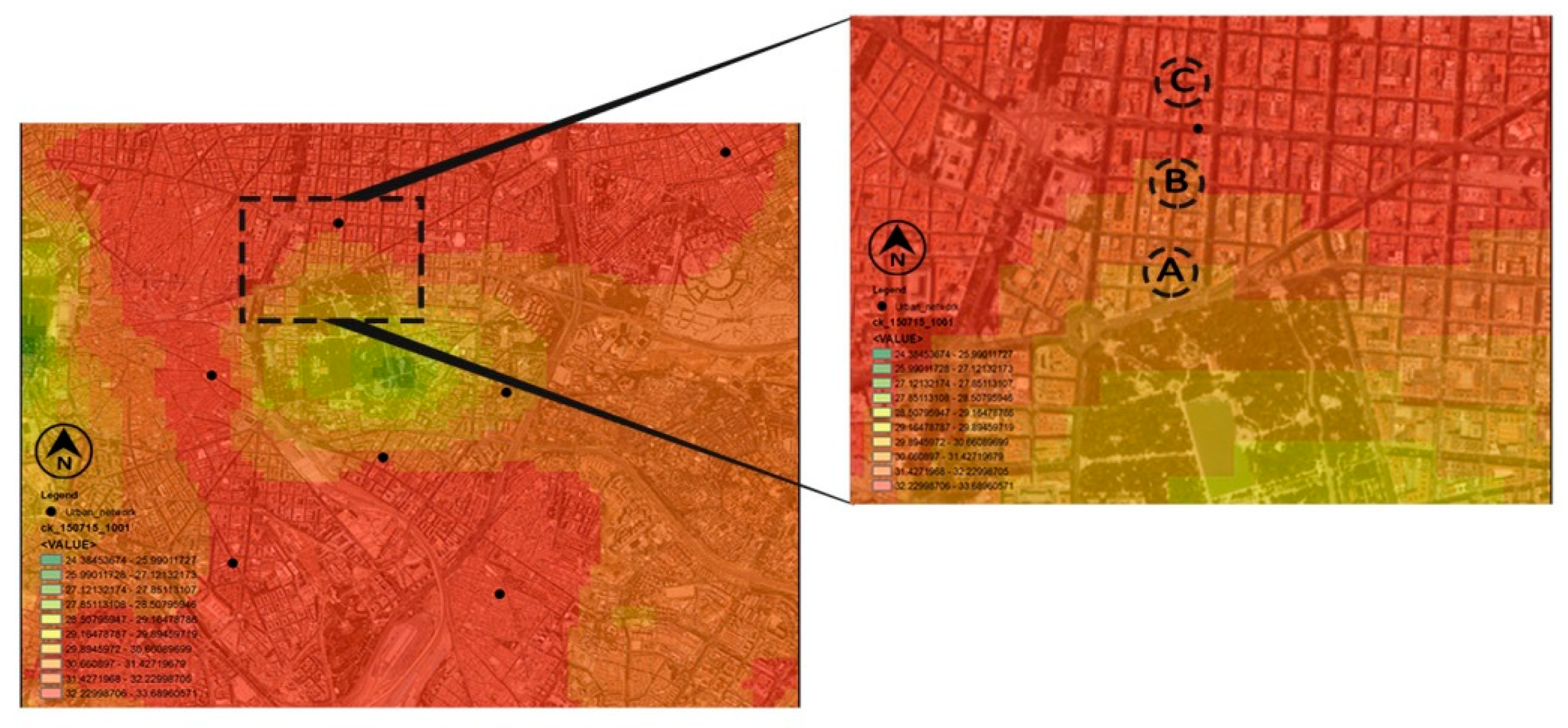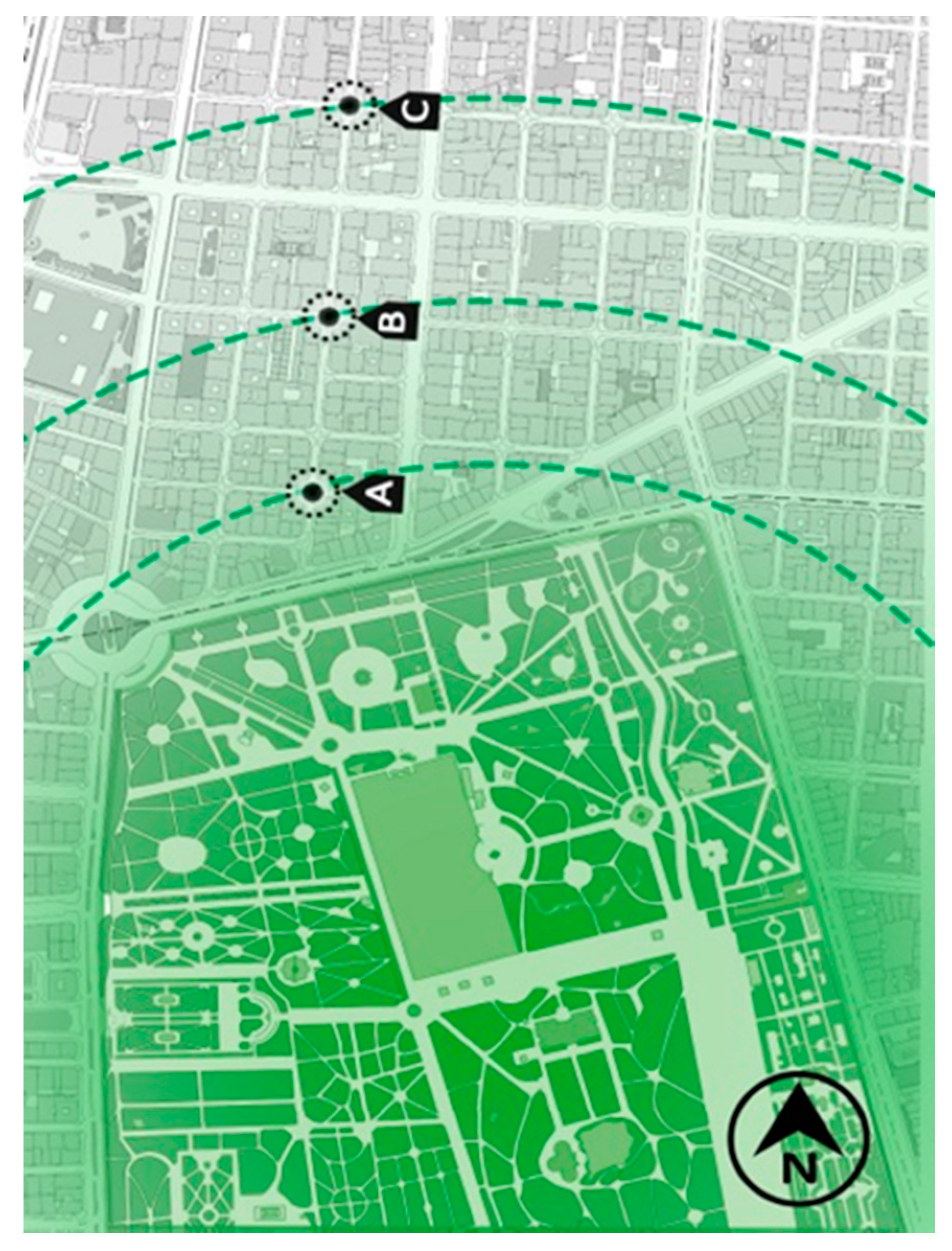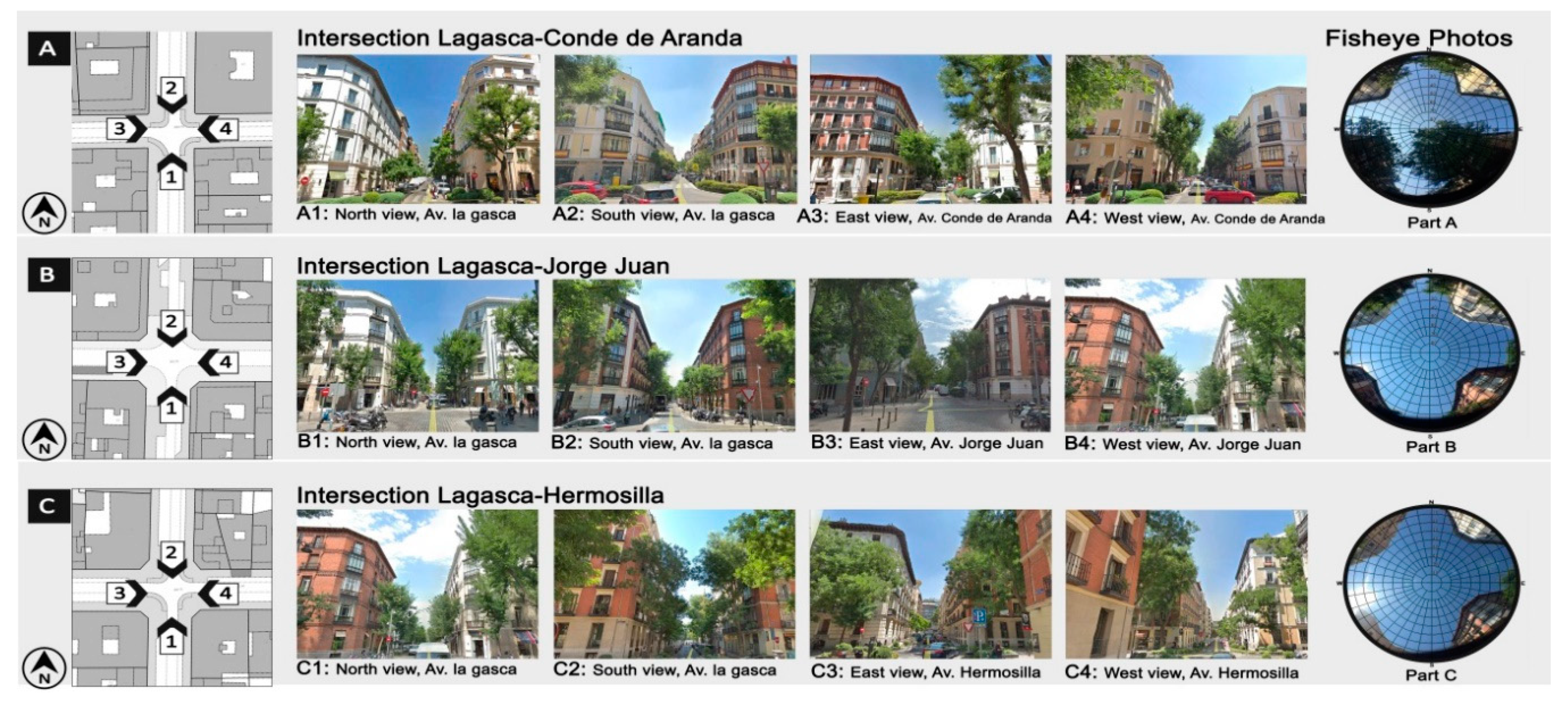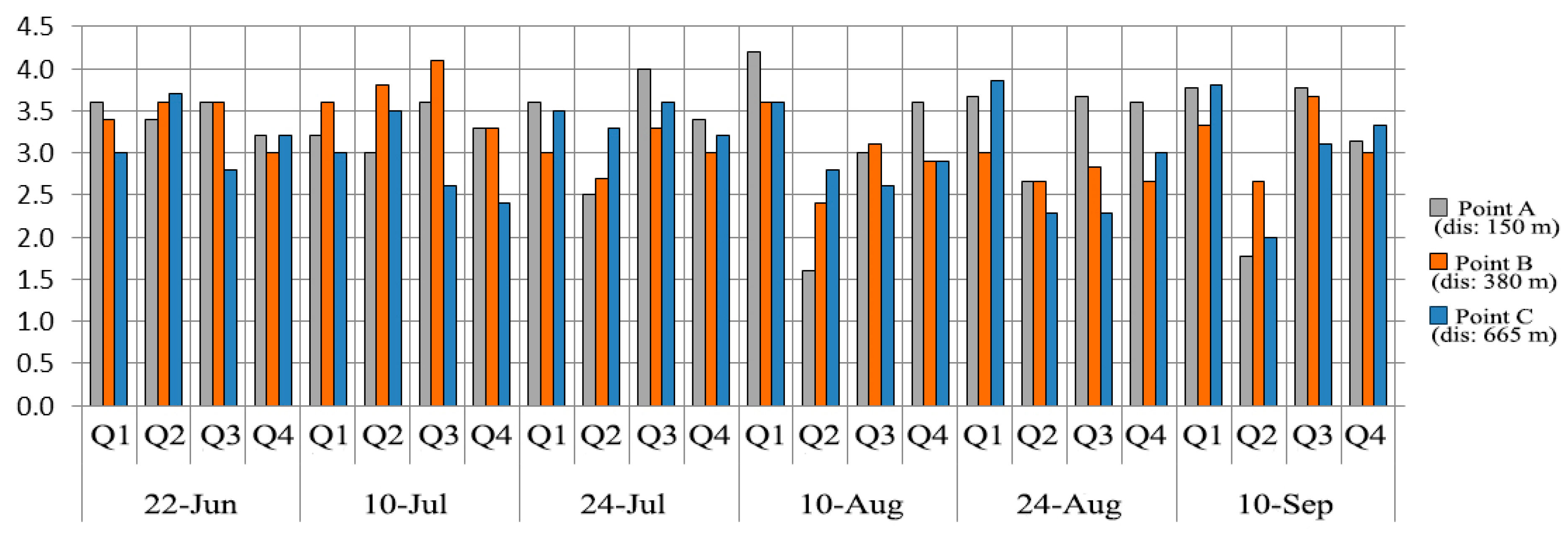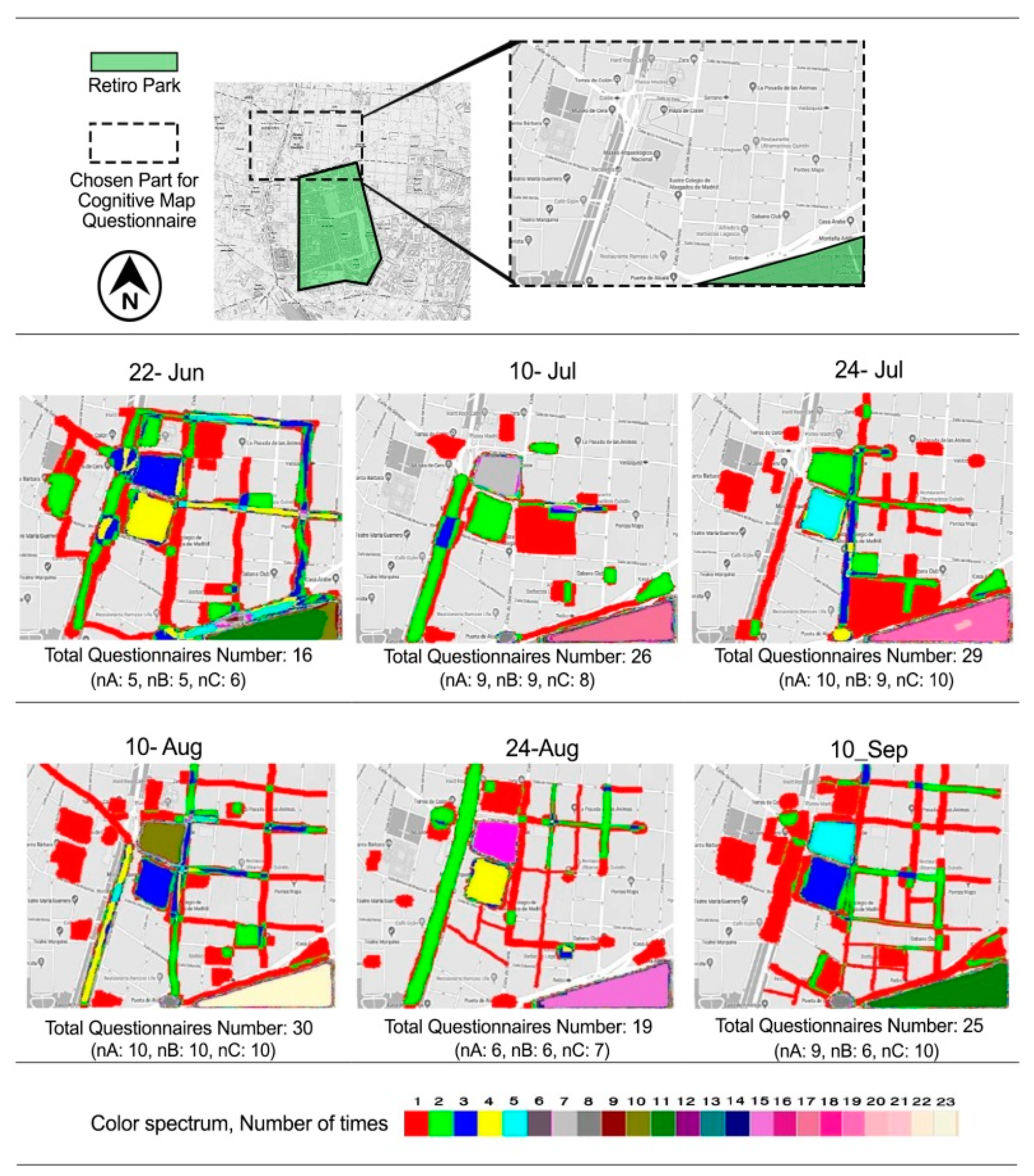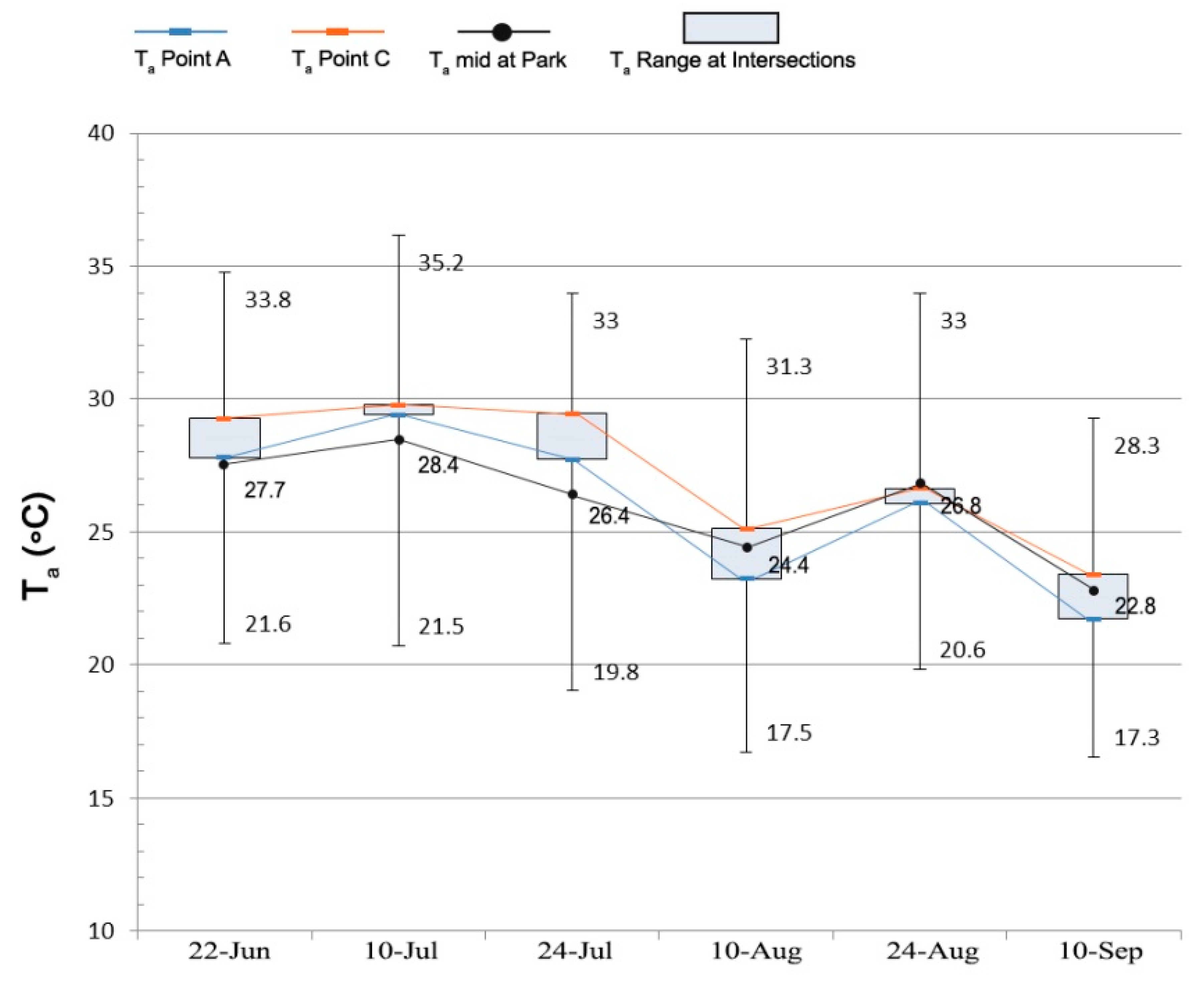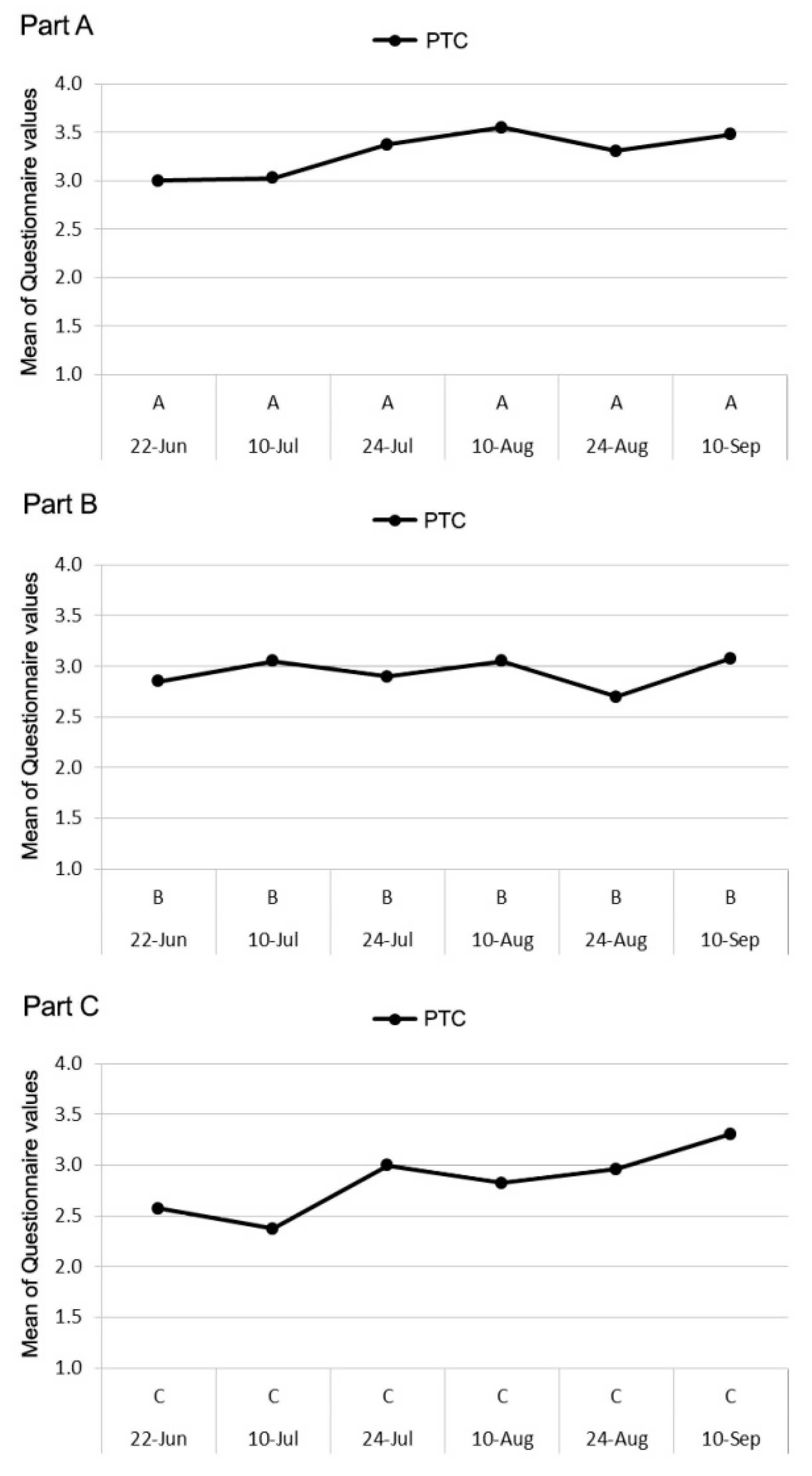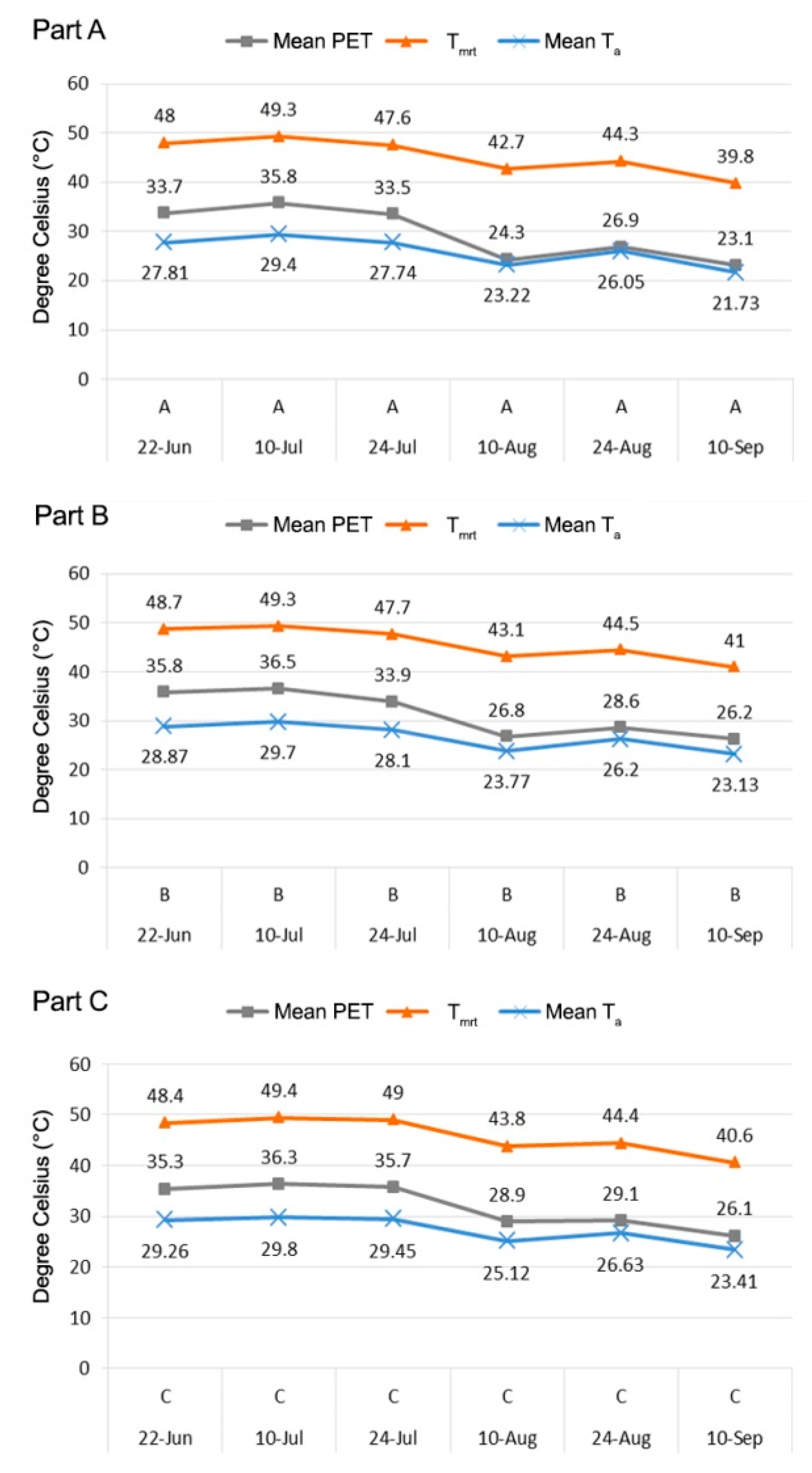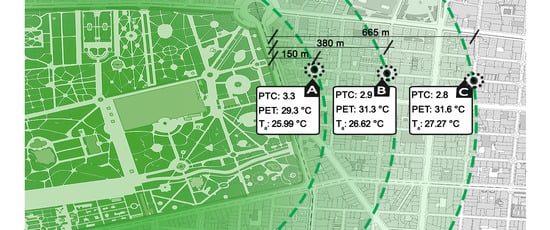1. Introduction
Due to climate change and the growing urbanization, the heat in cities is rising rapidly [
1,
2]. Today, heat has adversely affected urban life across the world [
3], including urban areas of the Mediterranean climate [
4,
5]. The increase in temperature in urban areas, especially densely populated areas has given rise to the phenomenon of urban heat islands (UHI) [
6,
7], which can threaten the health and comfort of citizens [
8,
9]. The green urban spaces have been researched by numerous studies as an adaptive strategy to reduce the effect of urban heat and improve the health of citizens, by considering thermal comfort [
10,
11] as well as their socio-economic role [
12]. Various studies have been conducted on the effects of various types of green infrastructures aiming at reducing urban heat and thermal discomfort [
13,
14], which include different scales and forms such as small local parks [
15], large urban parks [
16], urban gardens [
17], green roofs [
18,
19], green walls [
20,
21] and street trees [
22,
23]. This study emphasizes the cooling effect of large urban parks.
The studies conducted on large urban parks have shown that such parks have a significant effect on air temperature reduction and UHI [
24,
25,
26], which is especially noticeable during the summer [
27,
28]. However, it is noteworthy that the temperature drop does not only take place within the park but also surrounding areas [
29]. The cooling effect of urban parks, referred to as a park cooling island (PCI) [
30], is known to affect the surrounding environment depending on the area of the green space and quality of green coverage [
31,
32]. Two relevant indices to measure the cooling effect of urban parks are the cooling effect distance (CED) and cooling effect intensity (CEI) [
33], which have been extensively used in various scales and climates [
34,
35,
36].
Studies on the cooling effect of urban parks in different regions have shown that large scale urban parks with areas over 10 ha can have an average of 1 to 2 °C effect on surrounding areas that are an average of 350 meters away [
33]. In general, air temperature reductions in urban parks are typically up to 0.5–4 °C and may even cause up to 5–7 °C reduction [
37]. Despite the cooling effect of urban parks on their surroundings, such an outcome is not merely dependent on the traits of the green space [
38]. The morphology of the surrounding area of parks, the sky view factor (SVF), the spatial configuration of the location, and the covered area, also affect the perception of the cooling effect of urban parks and thermal comfort [
37,
39].
Numerous studies have been carried out on the cooling effect of urban parks. However, research pertaining to the extent of this effect on thermal comfort perception from psychological and physical perspectives is limited. This gap necessitates examining the cooling effect of urban parks on the aforementioned parameters at different intervals from the park to determine factors that may be applied in sustainable urban development.
2. Park Cooling Effect and Thermal Comfort Perception
A set of thermal indices was investigated in two experimental (effective temp (ET), resultant temp (RT), humid operative temp (HOP), operative temp (OP) and wind chill index (WCI)) and analytical (index of thermal stress (ITS), heat stress index (HIS), effective temp (ET*), stand. effective temp (SET*), out. stand. eff. temp (OUT_SET), predicted mean vote (PMV), perceived temp (PT) and physiological equivalent temperature (PET)) groups [
40,
41,
42,
43]. The basis of these analytical indices was the energy balance (produced and wasted human energy). The main issue of thermal indices pertains to the average thermal comfort assessment and climate conditions of each area [
44]. The result of various studies on validating other indices shows that examples such as SET and PET have a high correlation (89%) with thermal comfort in open spaces [
45]. Most studies in recent years have utilized SET, PMV and PET to predict comfort levels in open spaces [
46,
47,
48].
PET enables the comparison of the full effect of thermal conditions about the outside environment with individual experience [
49,
50]. PET is one of the recommended indices in urban and regional urban planning around the world, used to predict thermal changes of urban or regional clusters [
51]. This index has shown a significant correlation to thermal comfort in various climatic conditions in open urban spaces as validation [
52]. One of the prominent influencing factors on PET condition is the T
mrt (mean radiant temperature) climate variable. The indices mentioned above provide a single image of a set of individual and climate variables and enable the comparison of comfort conditions in various environments (due to global factors) [
53].
In studies conducted to investigate the thermal comfort of urban parks, the PET index is commonly used. In a study conducted on a warm sunny day in Beijing, China (21 August, 2 pm) [
54], it was shown that the effect of the Yuan Dynasty Relics green space with 102 ha area, in close approximately to the area of Retiro Park, reduces the PET by an average of 2 °C and a maximum of 15.6 °C. Another study conducted at Zhongshan Park in Shanghai city center with an area of 21.42 ha, showed that the PCI led to thermal comfort during Shanghai’s winter as well as summer and had a PET of 15–29 °C [
55]. Additionally, a study conducted at the Central Park of Cairo with an area of approximately 26.01 ha [
56] showed that parks had a significant effect in enhancing thermal comfort during summer, which, based on this effect, entailed a PET value of 22–30 °C throughout the day.
While the cooling effect of urban parks has generally been recognized as a strategy for mitigating urban heat and providing thermal comfort [
57,
58], the extent of perceived thermal comfort stemming from the cooling effect of urban parks is difficult to predict, necessitating investigations of people’s attitudinal and bodily experiences concerning physical thermal conditions at various intervals in the surrounding areas of these parks [
59,
60]. The degree of perceived thermal comfort by an occupant, which is caused by the cooling effect of urban parks, is dependent on factors such as individual behavioral and psychological traits, in addition to distance and cooling effect intensity [
61,
62,
63]. Individual demographic traits include age, gender, and physical characteristics such as height and weight of occupants [
64,
65]. Psychological traits include the individual’s experience of being in the environment and their thermal expectations and tolerance [
66,
67]. Behavioral aspects include the extent of being covered (in terms of clothes) and the type of activities conducted by the individual [
68].
A common method to determine the extent of thermal comfort experienced by occupants is the use of surveys [
69]. Essentially, by using such survey methods as open, semi-open, or multiple-choice questions [
70], individuals can be asked about their thermal comfort experiences [
71]. In order to measure the human thermal comfort perception level, cognitive mapping can be utilized in combination with questionnaires. Employing this method and asking residents to identify places where they feel more comfortable from a thermal point of view provided a more comprehensible image of the residents’ thermal comfort level for understanding [
72,
73]. In recent years, utilizing questionnaires and asking direct questions about the perceived comfort of citizens alongside micro-climatic perceptions have yielded valuable results [
74].
Many studies have been conducted on the cooling effect of urban parks, particularly their CEI and CED effects. However, less research has been carried out on the thermal comfort of this effect at different distances from the park. Additionally, few studies on the cooling effect of urban parks on thermal comfort have mainly investigated through physiological indices. As both psychological and physical perspectives together provide the complete concept of thermal comfort, it, therefore, necessitates examining the extent of thermal comfort created by urban green spaces from either perspective.
The purpose of this study is to investigate the cooling effect of the large urban park and its effect on the thermal comfort of occupants in the areas around the park. This study focuses on the perceived thermal comfort (PTC) and physiological equivalent temperature (PET) of locations, at a defined distance from the park and similar in terms of urban aspects and influential factors such as floor coverings, enclosures, street canyon and vegetation, whilst responding to the following research questions:
What is the extent of the large urban park cooling effect on thermal comfort based on PET?
What is the extent of the large urban park cooling effect on occupants’ PTC?
What is the relationship between the measured PTC and the measured occupant PET?
4. Results
Data was gathered during six days in hot summer, on 22 June, 10 and 24 July, 10 and 24 August and 10 September at three different intersections at different distances from the northern area of Retiro Park (
Table 2). The selected data collection time interval was generally between 10:40 and 12:10 CEST (the exact time of each intersection is given in
Table 2). This time was chosen since it was between the maximum and minimum temperatures in the park, so the temperature data extracted at points A, B and C were close to the average park temperature (mid-temperature taken by the AEMET weather station [
76] on the data extraction days;
Table 6). Based on
Figure 6, the temperature range for points A, B and C (gray rectangle) was between the maximum and minimum extracted park temperature (linear range). It is noteworthy that among the three areas, the average temperature of point A was closer to the average temperature of the park (mid-temperature;
Table 6) compared to the other points. AEMET data showed that the lowest and highest temperatures pertaining to the data extraction days in the Retiro Park were related to the 4:50–6:00 and 13:40–14:40 CEST timeframes.
Gray rectangles: Temperature range at three intersections (bottom side: Ta A, top Side: Ta C).
Linear range: The temperature range of the park is based on AEMET (bottom line: Ta mid of park, top line: Ta Max of the park.
The mean Ta for points A, B and C are 25.99 °C, 26.62 °C and 27.27 °C, respectively. The Ta difference over the measurement days between distance of 150 m (A) and 380 m (B) from the park was about 0.63 °C, between B and C (distance of 665 m) was about 0.65 °C and for the difference between A and C, the temperature difference was about 1.28 °C. According to the results, as the distance from the park increases, the temperature and its difference with areas closer to the park will be greater.
4.1. Assessment of the Park’s Cooling Effecting on Thermal Comfort Indices
In this section, PET data and questionnaire results were used to assess the cooling effect of Retiro Park on thermal comfort. PET data are derived based on the indices standard and the perceived thermal effect is obtained based on the average questionnaire and cognitive maps data. By using both these data, the extent of thermal comfort originating from the Retiro Park cooling effect at distances A, B and C could be deduced as physiological and psychological points of view.
4.1.1. Comparison of the Park Cooling Effect Significance on PET at Different Distances from the Park
In a more accurate analysis using SPSS software, a one-way ANOVA was used to analyze the relationship between distances A, B and C from the park and the relevant PET differences. Upon every variance analysis and in the case of significant mean difference (the significant level of a
p-value less than 0.05), Tukey test, which is a series of post-hoc tests, were used to accurately determine which of the average of a variable has a significant difference [
89]. Essentially, by using this test, the thermal comfort relationship was deduced based on the PET index, which was obtained using the Ray Man software on distances A, B and C.
The results of the ANOVA test (
Table 7) show that concerning the PET index, there was a lower significant error rate (0.05) and 95% confidence level of a significant difference between average PET data in each of the A, B and C points (
p-value = 0.029). Therefore, Tukey’s post-hoc tests were used to determine whether there is a significant difference between each of the A, B and C intersections.
The results of this studied grouping test are presented in
Table 8. According to this table, it can be stated that there was a significant relationship between the mean PET index at points A and C but the mean PET index between point B with points A and C did not entail a significant difference. The mean PET for A, B and C was 29.3 °C, 31.3 °C and 31.6 °C, respectively. Essentially, it can be stated that the PET index difference among intersections A and C was explicit and significant (
p-value = 0.036). The mean of this index in A had a difference of 2.3 °C with C, while the difference between A with B was about 2 °C, which was not considered significant in terms of the Tukey test (
p-value = 0.09).
4.1.2. Comparison of the Significance of the Questionnaire Dataset PTC at Different Distances from the Park
In order to compare the significance of the PTC at different distances from the park, the mean dataset extracted from the questionnaire for each section was derived as the PTC. The questions answered by citizens via the questionnaire were about how they felt about the ambient temperature and the effect of Retiro Park on such feelings in the form of four questions (
Table 3).
Based on the results of the ANOVA statistical test (
Table 9) and a lower significance error level (
p-value < 0.05), there was 95% confidence pertaining to a significant difference between mean thermal comfort index (PTC) in each of the A, B and C regions (
p-value = 0.032). Thus, Tukey’s post-hoc test was used to determine the significant difference between each of the intersections.
Since the rating of questions was from very low to very high in the form of numbers 1 to 5,
Table 10 shows that the average of the total questions during the 6 days for A, B and C was approximately 3.3., 2.9 and 2.8, such that area A was of the highest share indicating more thermal comfort experienced by people in this area. In interpreting the table above, it can be stated that there was a significant difference between the mean PTC index at points A and C (
p-value < 0.05), but the mean PTC at point B with points A and C had no significant difference. Based on this relationship, it is also clear that with an increase in distance from the green area, the perceived comfort experienced by citizens was reduced; thus there was an inverse correlation between increased distance and PTC.
4.1.3. Comparing the Cognitive Maps Significance at Different Distances from the Park
The meaningfulness of the cognitive maps data with the distance from the park was evaluated using the ANOVA test. The analysis of this section was performed by using a AramMMA software for analyzing cognitive maps. In this analysis, the maps pointing to the Retiro park were distinguished from maps that did not mention the park. In fact, 100 percent of the score was dedicated to the maps noting parks, while zero percent was considered for those that did not mention to the park. The result of the ANOVA test (
Table 11) illustrated that there was an acceptable agreement (95%) between the correlation of cognitive maps and the distance from the park (
p-value < 0.05).
Owing to the agreement, in each of the A, B and C regions the Tukey test was used separately, and the results were as follows. As illustrated (
Table 12), 87.7%, 60% and 50.9% of the respondents in the A, B and C areas, respectively, referred to the park. As expected, the highest level of cognitive mapping from the park is in the vicinity of the park area (150 to 380 meters). Nevertheless, in the C region, with 665 meters distance from the park, more than half of the respondents claimed that the site was comfortable thermally thus preferring to spend more time there. The difference between A and C was also meaningful (
p-value = 0.000). The good agreement of this relationship depicts the impact of the Retiro park (as a place with a high level of thermal comfort) on the resident’s mental images and psychological dimensions.
4.1.4. Comparison of the Significance of the Questionnaire Dataset PTC with PET
For a closer assessment of the effect of Retiro Park on thermal comfort, the PET index and PTC by citizens were compared on the basis of the total data extracted from the questionnaire. Mainly, this PET analysis, which is a standard index for perceived thermal comfort, was compared with the personal opinion of people about their perceptions concerning the thermal comfort of the environment. SPSS software was used to assess the correlation test as well as other statistical tests.
Based on the results of the Pearson correlation test (
Table 13), the relationship between the PET index with thermal comfort in the selected points of A and C was significant (
p-value < 0.05) and was of inverse correlation (−0.404 and −0.379
). Due to the medium correlation coefficient (medium = −0.3 to −0.5) [
90,
91,
92], the relationship between the PET index and the PTC in area A (
p-value = 0.004) was more significant that of area C (
p-value = 0.006). Moreover, the significance of PET index relationship with perceived thermal comfort in area B (
p-value = 0.061) was not accepted (
p-value > 0.05).
4.2. Relations Between Thermal Comfort Indices (Physiological and Psychological)
Regarding the results, by increasing the distance from the park at intersections B and C, despite physical and structural similarities to the intersection the A, there was an increase in air temperature (Ta), and consequently, the extent of PET and Tmrt also changed accordingly.
The data pertaining to the perceived thermal comfort (PTC) acquired from the questionnaire was rated from 1 to 5 (1 = very low to 5 = very high) and at points A, B and C during six days were on average approximately 3.3, 2.9 and 2.8, respectively (
Table 10). At point A, residents experienced higher thermal comfort compared to the other points. Essentially, the level of PTC at this location was medium to high according to citizens’ opinions (medium = 3), whereas for B and C, the average perceived thermal comfort for the data extraction days was lower than medium. Furthermore, the results show that the extent of PTC at intersection A was more significant in all the days (
Figure 7). It is noteworthy that based on statistical data, the perceived thermal comfort was correlated to PET and was of inverse correlation, such that its graph behavior was inversely correlated with the PET graph (
Figure 7 and
Figure 8). For example, on 10th August, where the PET value was at a minimum at point A (PET 24.3 °C), the relevant perceived thermal comfort was at a maximum (3.6) or on 10th July, at point C, the PET was 36.3 °C, which was higher compared to other points and days which was inversed in the perceived thermal comfort graph and the least value of this index was at point C with a value of 2.4. In addition to the similar behaviors of PET, T
mrt, T
a and PTC parameters at each intersection during the six days of assessment (
Figure 7 and
Figure 8), the credibility of the data and calculations conducted in this study were approved.
Based on the results, it can be said that Retiro Park played an essential role in providing thermal comfort to the citizens during the summer days in downtown Madrid, which was physically and psychologically debatable. As mentioned, Madrid has a Mediterranean climate that is characterized by hot summers. Studies in the Mediterranean climate have shown how urban green spaces can reduce the impact of urban heat [
93,
94]. A study carried out in Greece, Athens [
95], found that the urban park on the western margin of Athens during the hot summer days could reduce daytime air temperature between 0.2 °C and 2.6 °C. In a similar study conducted in Lisbon, another Mediterranean city during the six days of summer 2007 and 2008 [
96], the results showed that a 0.24 ha urban park was able to reduce the air temperature inside the park to 6.9 °C compared to its surrounding air temperatures. These studies and the studies mentioned in the first part of the article indicate that large-scale parks affect their surroundings through cooling down their environment. This is significant for Retiro Park due to its variety of vegetation and vegetation density compared to previous studies. The cooling effect of the park can cool over a distance of 350 m in its northern part, with a dense and regular texture, between 0.06 and 1.28 °C compared to the 655 m range near Heat Island.
As noted earlier, little is known about the cooling effect of urban parks on thermal comfort, and most of the studies have focused on the CED and CEI levels. However, in the Mediterranean areas, a study was carried out in Israel investigating the thermal comfort of urban parks using the PET index.
In this study conducted by Cohen, Potchter and Matzarakis [
97], a total of 10 urban parks of various areas (0.2 to 0.36 ha) were assessed in Tel Aviv. Although the investigated parks were smaller in terms of area compared to Retiro Park, the results illustrated that parks with richer vegetation density had greater cooling effects and thermal comfort, and could reduce temperatures by up to 3.8 °C whilst bringing PET to 18 °C during hot summer.
This study proved how important this is in areas with hot summers. However, in this study and other studies on the thermal comfort of large urban parks, less attention was paid to the thermal comfort from a psychological point of view. In this study, in addition to assessing CED and CEI of a park and thermal comfort from the physiological point of view (PET), mental thermal comfort through questionnaires (PTC) and cognitive maps were also investigated. Based on the results, the significance of both PTC and PET indices was confirmed. The two indices were inversely correlated, and when the cooling effect was reduced by the distance from the park, the PET rate increased and the PTC level decreased, which indicates the impact of the cooling effect of the large urban park on the thermal comfort from both psychological and physical perspectives.
In this regard, the role of large urban parks was tangible in providing thermal comfort for citizens and it is necessary to pay more attention to various levels of urban planning and sustainable development.
5. Conclusions
This study examined the potential of large urban parks in providing thermal comfort for citizens living within the park perimeter. The results extracted amidst six hot summer days in Madrid show that large urban parks exhibit a cooling effect. Considering the significance of the mean Ta difference between the distance of 150 m and 665 m from the park (p-value < 0/05), as well as the lower temperature of about 1.28 °C pertaining to the distance closest to the park compared to distances further away from the park (under equal conditions), in addition to the insignificant mean Ta difference at the distance of 380 m compared to 150 m and 665 m (p-value > 0/05), we found that the cooling effect of the large urban park at distances close to the park (under 380 meters) had a significant role in temperature reduction.
Accordingly, the level of PET would increase as the distance from the park increased, and residents would perceive less thermal comfort compared to distances closer to the park. The degree of PET index at a distance of 150 meters from the park was on average 2 °C PET and 2.3 °C PET less compared to distances of 380 meters and 665 meters respectively. The PTC of citizens was acquired based on the average obtained data from the questionnaire, which showed that people in the vicinity of the park experienced more thermal comfort. For the other two regions of the park, which were more distant, less thermal comfort was experienced (less than average).
The results of the cognitive maps analyses demonstrated that large parks played a significant role in thermal comfort improvement affecting people’s mental map. For people, such parks are a space where they feel more comfortable, thereby spending more time to enjoy the desirable temperature. Although the resultant mental maps were closer to residents in the vicinity of parks, the results demonstrated that at long distances to the park (665 meters) those locations still had a psychological dimension in offering thermal comfort (more than 50%).
PET and PTC as the main variables of this research were inversely correlated such that when the distance from the park was increased, the PET was increased and thermal comfort was decreased. The correlation between the two indices was significant in the nearest and furthest distance from the park (p-value < 0.05) and the highest correlation coefficient of the two indices pertains to the distance closest to the park (150 meters). Essentially, this indicates the high level of perceived thermal comfort from the citizens’ point of view as well as the PET compared to distant locations.
As a result, the cooling effect of a large urban park was a suitable solution to improve people’s thermal comfort (as physiological and psychological perspectives) either within the park area or in the vicinity of the park. The results of this study clarified that in areas close to the park, such an effect on thermal comfort is more perceptible. Thus, in order to enhance the cooling effect of large urban parks, it is necessary to implement urban design and planning solutions (qualitative and quantitative) to provide more favorable conditions for the lives of citizens.
